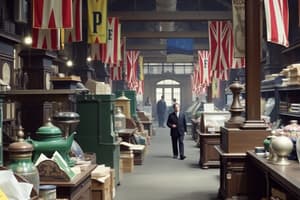Podcast
Questions and Answers
During the Second Industrial Revolution, what new characteristic was seen in corporations?
During the Second Industrial Revolution, what new characteristic was seen in corporations?
- Emphasis on artisanal craftsmanship
- Formation of monopolies (correct)
- Increased government regulation
- Decrease in production efficiency
What significant change occurred in women's role in society during this period?
What significant change occurred in women's role in society during this period?
- Became more prominent in political and social movements (correct)
- Maintained traditional roles unchanged
- Saw a decrease in participation in the workforce
- Lost the right to vote in many nations
In the context of the Balkans crisis and the weakening of the Ottoman Empire, what did the Ottomans seek to do to maintain power?
In the context of the Balkans crisis and the weakening of the Ottoman Empire, what did the Ottomans seek to do to maintain power?
- Ceded control of the region to neighboring powers
- Implemented significant military reforms (correct)
- Encouraged secessionist movements within their empire
- Strengthened their economic ties with Russia
What development played a crucial role in the birth of Russian socialism during this period?
What development played a crucial role in the birth of Russian socialism during this period?
Which of the following was a notable impact of the birth of the idea of Zionism during this period?
Which of the following was a notable impact of the birth of the idea of Zionism during this period?
What strategy was initially employed by the Allies regarding Germany and how did Germany take advantage of it to expand?
What strategy was initially employed by the Allies regarding Germany and how did Germany take advantage of it to expand?
How did the Treaty of Versailles and the Great Depression impact Europe, particularly Germany?
How did the Treaty of Versailles and the Great Depression impact Europe, particularly Germany?
In the context of World War II, what led to the involvement of the United States and Russia in the war?
In the context of World War II, what led to the involvement of the United States and Russia in the war?
What were the main turning points of the war that shifted the favor towards the Allies?
What were the main turning points of the war that shifted the favor towards the Allies?
What was the significance of Gorbachev's policies of Glasnost and Perestroika in the context of the Soviet Union's collapse?
What was the significance of Gorbachev's policies of Glasnost and Perestroika in the context of the Soviet Union's collapse?
Flashcards are hidden until you start studying
Study Notes
Chapter 24: World War I
- The alliances system, military growth, nationalism, and the crisis in the Balkans contributed to the outbreak of World War I
- The July Crisis, sparked by the assassination of Archduke Franz Ferdinand, led to a chain reaction of events that escalated into a global conflict
- The war resulted in a stalemate, with both sides attempting to break through the trenches using new military tactics and technologies
- Britain utilized Zionism and nationalism to mobilize support for the war effort
- The concept of "total war" emerged, involving the mobilization of entire societies and economies for the war effort
- Women's roles in society shifted as they took on new responsibilities in the workforce and military
Chapter 24: Russian Revolutions
- The war had a profound impact on Russia, leading to the outbreak of two revolutions in 1917
- The February Revolution led to the abdication of Tsar Nicholas II, while the October Revolution saw the Bolsheviks seize power
Chapter 24: Treaty of Versailles
- The Treaty of Versailles imposed harsh penalties on Germany, including massive reparations and territorial losses
- The treaty's emphasis on self-determination led to a redrawing of national borders and the creation of new states
Chapter 25: Interwar Period
- Stalin consolidated power in the Soviet Union through purges, propaganda, and economic reforms
- Fascism emerged in Germany and Italy, promising national rebirth and authoritarian leadership
- The Treaty of Versailles and the Great Depression had devastating consequences for Europe, particularly in Germany
- Hitler rose to power in Germany, promising to restore national pride and prosperity
Chapter 26: World War II
- The policy of appeasement failed to prevent German aggression, allowing Hitler to expand his territory
- International crises, including the invasion of Poland, led to the outbreak of World War II
- The US and USSR entered the war, turning the tide in favor of the Allies
- The Holocaust, a genocide targeting Jews and other minority groups, was carried out by the Nazi regime
Chapter 27: Post-War World
- The West, led by the US, sought to contain Soviet influence and promote economic recovery
- The formation of NATO and the Soviet counter-alliance marked the beginning of the Cold War
- Decolonization and proxy wars shaped international relations in the "Third World"
- Apartheid was established in South Africa, institutionalizing racial segregation and discrimination
Chapter 28: Late 20th Century
- The 1970s saw economic stagnation in the West, while Gorbachev's reforms in the Soviet Union led to its collapse
- The Velvet Revolution marked the end of Soviet dominance in Eastern Europe
- Global interconnectedness has increased, shaping modern societies, governments, and economies
- The "Second" Industrial Revolution transformed industries, leading to the formation of monopolies and new corporate structures
Studying That Suits You
Use AI to generate personalized quizzes and flashcards to suit your learning preferences.




